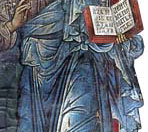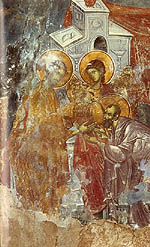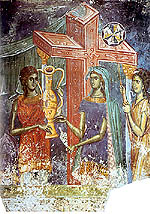
 |
  |
|
 |
|
The
Church of St. Demetrius, St. Procopius and Archangel Michael, 1346
|
The church has a fairly simple structure. It is an edifice with the ground plan in the form of a shortened inscribed cross built of alternative courses of stone and bricks. This combination of building materials contributes to the decorative appearance of the exterior. The Church of St. Demetrius is a comparatively low building, with a dominating large dome and a drum, the edges of which are emphasised by half-columns. The weight of the dome is transferred on to the walls by means of pendentives, and it is also supported by a pilaster on the north side.
Two remarkable architectural features are noticeable in the simple interior. The sanctuary is considerably more spacious than in the other Serbian churches dating from the first decades of the 14th century. In contrast to this, the west bay - the area near the entrance to the church, is lower and not so well lit. It is roofed with a cross vault and it may have been built subsequently, in place of an earlier one dating from the time of Archbishop Nikodim. Viewed as a whole, the Church of St. Demetrius is considerably dependent on the mother church of the entire group, the Church of the Apostles, and therefore it does not conform fully to the stylistic conceptions of the early 14th century architecture. However, the noble simplicity of its architectural design contributes considerably to the monumental appearance of the whole.
 |
|
The
Church of St. Demetrius, Council of St. Sava of Serbia and of King
Milutin, 1346
|
In the time of Patriarch Jovan, before 1614, the damaged parts of the church, especially the north wall, were rebuilt, but the original architectural design was not interfered with.
The entrance to the Church of St. Demetrius is framed by a well proportioned stone portal designed in the neoclassical style characteristic of the epoch of the Palaeolog dynasty. It is carved neatly and precisely, and its varied floral and ornamental designs are executed in shallow relief.
The two sarcophagi in the west bay of the church, one of which contained the relics of Patriarch Jefrem, and the other those of Patriarch Sava IV, are carved in the same manner. The sarcophagus of Patriarch Jefrem, made of red marble, and placed against the north wall, is decorated with crosses and a rosette on the lid. The shallow relief on the sarcophagus of Patriarch Sava IV is more varied. In addition to a garland of small arcades near the bottom of the front side, the entire box-like sarcophagus is covered with floral ornaments and three-stranded plaited designs.
 |
|
The
Church of St. Demetrius, young King Uros, 1346
|
A bi-partite Gothic window in the apse also belongs to the carved decoration of the Church of St. Demetrius. Since it is obvious that it was inserted later and since it resembles the windows at Decani, it may be assumed that it was carved during the fourth decade of the 14th century.
The original and partly restored iconostasis in the Church of St. Demetrius is almost three metres high. Especially noteworthy are the parapet panels with traces of blue and red paint. Shallow relief covers these panels like a skilfully woven network. It seems likely that both the portal and the iconostasis partition were carved by the same master.
 |
|
The
Church of St. Demetrius, sarcophagus of Patriarch Jefrem, longitudinal
side, 14th century
|
While the iconostasis dates from the time of the construction of the church, the frescoes in the Church of St Demetrius were painted approximately two decades later. They were probably commissioned by Joanikije II, who was then the Archbishop of Serbia.
 |
|
The
Church of St. Demetrius, window in the apse, mid-14th century (after
A. Deroko)
|
This is indicated by the fact that there is on the west wall a representation of St Joanikije, an eminent monk of the 8-9th century who addresses, as the namesake and patron of the Serbian' archbishop, a prayer to the Virgin: "0, holy Virgin, grant the request of your servant Archbishop Joanikije". This figure dates the painting with fair precision, since we know that the future patriarch of Serbia was archbishop between 1338 and 1346, although this does not help to explain why me Church of St. Demetrius remained without wall paintings for such a long time.
 |
|
The
Church of St. Demetrius, St. Joannicius before the Virgin, 1346
|
Although the 14th century frescoes were considerably damaged over the years, so that they were partly restored at the beginning of the 17th century, their original contents can be reconstructed with fair precision, because the later painter followed the earlier arrangement of frescoes.
The first zone, above the base, contained the customary series of standing figures. They include the groups of warrior saints with two angels in the west bay (14th century) and on the north wall of the nave (17th century); the saint healers on the north wall of the west bay (14th century) and the hermits on the south wall of the nave (17th century) The most interesting group is, however, that on the south wall of the bay, which includes St. Sava of Serbia, and the portraits of Emperor Stefan. Dusan, his son Uros, and Archbishop Joanikije (14th century).
The second zone in the nave depicts the passion and miracles of St. Demetrius of Salonica, the patron of the church. This brief cycle begins on the north wall a scene showing St. Demetrius before Emperor Maximianus; there follow compositions of St. Demetrius blessing Nestor, Nestor defeating Lyzins, and St. Demetrius transfixed with a spear in jail (the last two compositions date from the 17th century). The cycle is continued on the south wall with a scene showing the funeral of St. Demetrius and another of St. Demetrius defending Salonica (only the upper half of both compositions date from the 14th century).
 |
|
The
Church of St. Demetrius, Communion of the Apostoles, detail, 1346
|
The Great Feasts are shown in the uppermost parts of the nave and the sanctuary (14th century, apart from The Entry into Jerusalem, The Crucifixion and The Descent into Limbo, which belong to the 17th century), whereas the Dormition of the Virgin and Pentecost are shown in the west bay (14th century). Two other scenes outside the cycle of the Great Feasts are shown in this area: The Laying of Christ into Grave, and the Three Marys at Christ's Grave (14th century). The First and Second Oecumenical Councils, as well as two domestic councils (the Council of St. Sava of Serbia and the Council of Stefan Nemanja and his great grandson King Milutin) are painted on the vault.
The first and lowest zone in the sanctuary shows, as usual, the Adoration of the Lamb (17th century); above it is The Communion of the Apostles (14th century), while the Virgin and two angels are shown in the top part of the apse (14th century). The lateral walls show, among other scenes, two incidents from the life of the Virgin: The Birth of the Virgin (to the south, 14th century) and Presentation to the Temple (to the north, 17th century). There is a large representation of the Ascension in the dome (14th and 17th centuries), while the four Evangelists, Mark and Luke (14th century) and John and Matthew (17th century) are shown on the pendentives.
 |
|
The
Church of St. Demetrius, Birth of the Virgin, detail, 1346
|
Although this repertoire is not exceptional in its contents, the 14th century frescoes in the Church of St. Demetrius are not uninteresting. They include rare iconographic cycles - that of St. Demetrius being one of them - unusual arrangement of scenes (Ascension in the dome, following the example of the Church of the Apostles), remarkable theological concepts - the representation of the Three Marys as a symbol of belief in the resurrection just above the sarcophagi of the patriarchs, and even some reflections contemporary life - St. Mercurius is armed with a cross-bow, then a new and deadly weapon.
Among the 14th century frescoes especially remarkable are those on the vault in the west part of the church, which show two Serbian councils. They obviously parallel the oecumenical councils represented next to them and reflect the efforts to preserve the purity of Christian doctrine m the Serbian state.
 |
|
The
Church of St. Demetrius, St. Mercurius with a cross-bow, 1346
|
Particularly valuable are the portraits of Emperor Dusan, his son Uros and Patriarch Joanikije. The unusual clothes worn by them have been interpreted as a result of the fact that the artist did not know what imperial and patriarchal robes looked like, since the Patriarchate was established and the Empire proclaimed in those very days. If this assumption is right, the completion of the paintings in the Church of St. Demetrius should be dated to the spring of 1346.
 |
|
The
Church of St. Demetrius, signature of the painter Jovan, the apse,
1346
|
The 14th century frescoes were painted by two experienced artists. One of them signed himself in Greek near the feet of the Virgin in the apse in modest words: "The gift of God by the hand of Jovan".
 |
|
The
Church of St. Demetrius, Nativity, detail, 1346
|
He was probably a Greek and he may have come from Salonica or from its district. His models reach back to the classical times, and he was obviously well educated. His figures, both individual and those forming parts of compositions, are beautifully proportioned and have harmonious movements, and his scenes are without superfluous details. The other painter, whose name is not known, differs considerably from Jovan in certain respects; he is inclined to circumstantial narration, his figures are not attractive, though they do not lack expressiveness, and their movements are stiff.
The signature of the artist who restored the damaged paintings in 1621/22 (referred to in the inscription on the north wall in the area beneath the dome) has not been preserved. Stylistic analysis indicates, however, that it was Georgije Mitrofanovic, the most eminent Serbian painter at the beginning of the 17th century. Although a monk from Chilandar, he lived outside his monastery between 1616 and 1621, and carried out many commissions in the region of the Patriarchate of Pec. He is primarily interested in the human figure and he tends to neglect the setting of the scene. He was an experienced master and he knew how to adjust his style to that of the paintings in the Church of St. Demetrius, so that his frescoes represent a fitting replacement for the lost parts of the original wall paintings.
Three saints and leaders of the Serbian Church, Nikodim, Arsenije and Maksim, are painted on the south wall of the west bay, probably at the end of the 19th century.
History
/ People / Spirituality
/ Churches / Arts
/ Links
Main page / Serbian